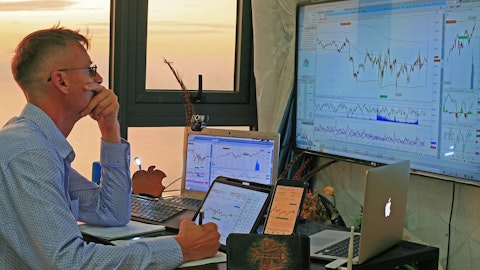Adam Jonas: I just want to follow up on Dan and Rod’s question and maybe in a different way, I apologize. But again, you expect to earn low- to mid-single-digit EBIT-adjusted margins in the EV portfolio kind of from 2025, before the impacts of clean energy credits. On my numbers at least, that’s going to be — it could be higher than Tesla’s margins. But putting that aside, if you are confronted with a choice of doing the 1 million or doing the mid-single-digit margin, if it had to be a choice and you couldn’t do both, my interpretation of what you just said is that you’ll prioritize volume. Is that the message here in the case that the economics did require you to make a choice on trade-off?
Mary Barra: Yes. Adam, I mean, I think we’re going to work toward profitable growth. I’m not going to say, as we’re sitting in 2025, second, third or fourth quarter, that we’re going to do this for that, depending on the situation. When you look at the portfolio that we’ll have, and I believe it’s the right portfolio, we’re not duplicating our ICE portfolio. We are very targeted in having the right vehicles from different price points because to get to a point where there’s that many EVs being sold in the U.S., recognizing competition as well, you have to meet the customer where they’re at from an affordability perspective. And I know you’ve written about that in some of your notes. So we’re going to look and be smart, maintain the brand value, the vehicle value, the residual value.
But we think with the portfolio, we’re going to be well positioned to achieve the 1 million units with the right profit margins. So — but we’re going to be nimble. So just to put an either/or out there, we’re going to make — I’d say, make our own luck as we do this with the right products and continued cost reduction.
Adam Jonas: Thank you, Mary.
Mary Barra: Okay. Thanks, Adam.
Adam Jonas: And I just had a follow-up for Kyle. A lot of tech companies are undergoing cost saving or restructuring kind of actions to give themselves a bit of a lower breakeven point, maybe some more run way given the changing capital markets environment. Now you obviously you have the luxury of having GM as a partner on a lot of levels. That’s a huge advantage. But I’m just wondering if you also would have identified some actions that could be taken to maybe reduce that burn rate going forward in a new environment.
Kyle Vogt: Yes. Thanks for the question. I mean, as we march towards profitability, which is a big focus for us. We’ve been looking for a lot of ways to do more with less and run really efficiently. And so, similar to what Paul mentioned across the board in terms of some of the structuring and streamlining inside of GM, we’re doing those types of activities in Cruise as well and seeing some good results there. But really for us, the focus is on rapid scaling and therefore, getting incrementally closer to profitability.
Operator: Thank you. Our next question comes from Dan Ives with Wedbush. Your line is open.
Dan Ives: So what would you say has been the biggest surprise this quarter on the positive? Something where either from a production perspective, cost or even efficiency from development and specific on the EV side, especially given the transformation that’s happening?
Mary Barra: Great question. And I would say it’s multiple that I’ve been extremely pleased with the organization on how we keep finding ways to drive efficiency. When I talked about the fact that our screen configurations were reducing by 60%, so really dialing in on how do we reduce complexity on EVs, by the way, it benefits ICE as well, to be able to have the right models with the right features and then the ability to really start taking advantage of the software platform. That’s what’s really being rolled out now that we have Ultium and Ultifi. And so that is something that I’m really proud of the team of what they’re doing. And then just overall, I knew we had a strong product set, but the strong customer and dealer reaction that we’re seeing to the products that we put out from an EV perspective, I think that also gives me a lot of confidence in the strength of execution.
And then finally, even as we’re in a year of rapid launches, I think we haven’t had this many launches. I think for more than a decade, the team still very aggressively is working to take cost out, as signified of what we’ve been able to do with taking 15% of the leadership structure out, which is — and the way that the teams are looking to optimize, reduce complexity, become more agile. So, it’s not only — I feel we have the right products and we’re really reducing complexity. I think we have the right culture that is really driving a continuous improvement mindset from a cost perspective. So Dan, those are the two things I’m most proud of.
Operator: Thank you. Our next question comes from Emmanuel Rosner with Deutsche Bank. Your line is open.
Emmanuel Rosner: My first question, Paul, I was hoping you could put maybe a little bit of a finer point in terms of what are the puts and takes you’re assuming for the balance of the year in terms of, I guess, revenue and cost. I mean it seems, based on your previous comments, maybe an assumption of some moderation in pricing in North America. But then I think your costs should be going down as a result of some of the headcount reduction. Is that directionally the right way? Are there any other important pieces?
Paul Jacobson: Yes. Emmanuel, I would say we expect pricing. So North America pricing was about a $1.3 billion benefit in the quarter. As we lap last year’s pricing increases, we expect or we’re planning for — I wouldn’t say we expect at this point, but we’re planning and assuming that we end up giving some of that back so that we’re essentially net flat for the year on that, whether that’s through incentives or through pricing changes, et cetera. So, a little bit of a giveback for the rest of the year. And like I said to the earlier question, that’s — most of that’s sort of backloaded. But if we see demand continuing to be strong, then I would say that we’ll probably outperform that assumption going forward. On the cost side, a little bit kind of moderation from where we were before.
We thought commodities and logistics would be down year-over-year. We’re now seeing that essentially be flat. Like I said, we’ve seen some pressure in steel and some other things in logistics across the board. So overall, production, up 5% to 10%, as we said; pricing relatively flat for the year, and that’s how you can kind of center on where we’re projecting at the midpoint.
Emmanuel Rosner: Okay. And then I guess as we’re trying to figure out your progress towards some of the EV margin targets, and I understand you’re not prepared to share some of the current economics, are you able to tell us, I guess, what portion of the Company’s CapEx and engineering is currently spent on EV? And what would be the targets for that EV share of CapEx and engineering maybe by mid-decade?
Paul Jacobson: Yes. So right now, we’ve said it’s about 3/4 is on EV. When you look at capital and engineering expense, we still have some mid-cycle vehicles that we’re doing on the ICE side. But largely, the engineering and the capital is going into the EV side. That will obviously, as we work through the transformation, go to 100% over the next few years.
Operator: Thank you. Our next question comes from James Picariello with BNP Paribas. Your line is open.
James Picariello: Can you clarify how the structural cost savings range is now trending for this year relative to the $2 billion GM’s targeting to be achieved by the end of next year. And then just how should we be thinking about the associated cash costs tied to this effort for this year?
Paul Jacobson: So fair question. As we said, when we launched the program last quarter, 30% to 50%, we expected to get in the first year. We’re now guiding to the high end of that range. So I think we’ll come in about 50%. That ultimately is going to offset some of the pressures that we’ve seen. So we may not see a full $1 billion come off of structural costs. But certainly, we’ll get the savings from where we were going forward. The biggest component of that is obviously the voluntary severance program. We disclosed about a $900 million cash charge associated with that. That will largely be spent this year. The rest of the things that we identified, whether it’s travel, IT, marketing or some of the complexity, we don’t expect will have significant cash costs associated with it.
James Picariello: Got it. That’s helpful. And then as we think about fleet mix and the general rule of thumb for the U.S. — for the industry in the U.S., I think the fleet channels have been starved of, of product for almost three years. Is this potentially helping the profitability of your fleet mix of the industry’s fleet mix for at least this year, just thinking about that dynamic?
Paul Jacobson: Yes, it’s a fair question. Obviously, we’re seeing gains in fleet. And I think the historical view of fleet as a discount chain to drive volume isn’t really there anymore. We’re seeing really strong pricing on the fleet side. And we expect that business is going to continue to grow and be a contributor to our margins.
Operator: Thank you. Our next question comes from Ryan Brinkman with JPMorgan. Your line is open.
Ryan Brinkman: And thanks too for the earlier comments on China. I do want to ask a bit more around your operations there, though, just because, on the one hand, it seems like less of a needle mover for total company profits than it used to be with North America more profitable than before and consolidated IO flipping from loss-making to profitable. But on the other hand, the equity income there was the lowest in some time, apart from a couple of quarters impacted by COVID closures. So can you talk about any one-time disruptions you might have incurred there in the quarter, such as paradoxically maybe around COVID re-openings as the virus spread or any other one-time factor? And then what is it that you need to do now to restore profitability to where you want it to be?
You’re strong at the low end of the EV market. I’m guessing that’s probably a more well-rounded higher-end EV lineup that you see the most opportunity to close the gap. So along those lines, can you help us in terms of like what that comment in the shareholder letter around 400,000, I think, Ultium EVs produced over ’22 and ’23 with 50,000 in the first half in the U.S., doubling the back half? What does that kind of squeeze to for your anticipated Ultium ramp in China? And then how are you thinking about the profitability impact to your operations in China once those EVs do launch, maybe in light of some of the recent EV pricing actions in that market?





